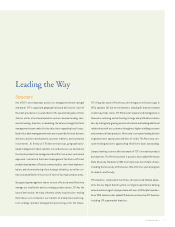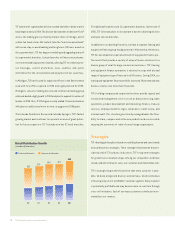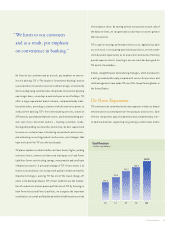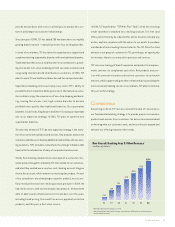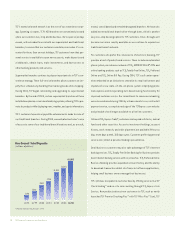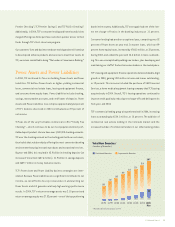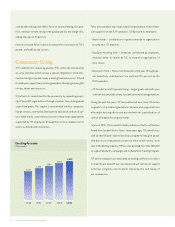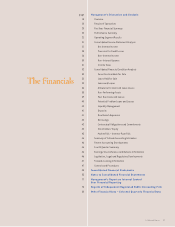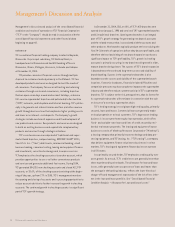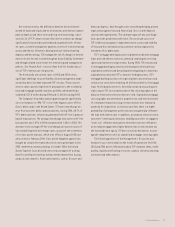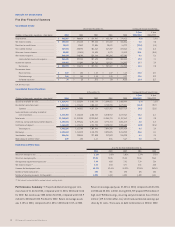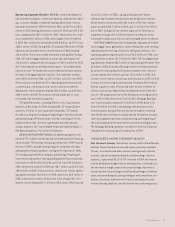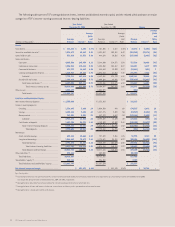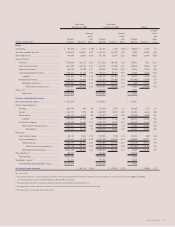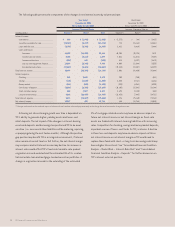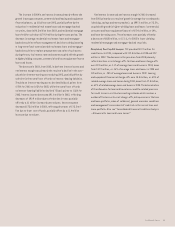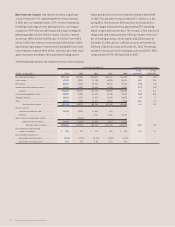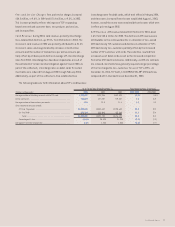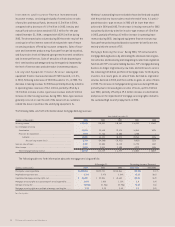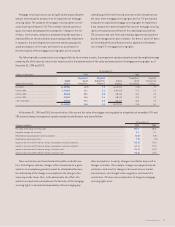TCF Bank 2004 Annual Report Download - page 21
Download and view the complete annual report
Please find page 21 of the 2004 TCF Bank annual report below. You can navigate through the pages in the report by either clicking on the pages listed below, or by using the keyword search tool below to find specific information within the annual report.
2004 Annual Report 19
Net interest income, the difference between interest income
earned on loans and leases and on investments, and interest expense
paid on deposits and short-term and long-term borrowings, repre-
sents 50.1% of TCF’s total revenue. Net interest income can change
significantly from period to period based on general levels of inter-
est rates, customer prepayment patterns, the mix of interest earning
assets and the mix of interest bearing and non-interest bearing
deposits and borrowings. TCF manages the risk of changes in interest
rates on its net interest income through an Asset/Liability Committee
and through related interest rate risk monitoring and management
policies. See “Market Risk – Interest-Rate Risk” for further discus-
sion of TCF’s interest rate risk position.
The historically low interest rates in 2003 and 2004 were a
significant challenge to asset/liability risk and management made
several key decisions that impacted TCF’s results. These very low
interest rates caused a high level of prepayment in the residential
loan and mortgage-backed securities portfolio, which declined a
combined $111.8 million during 2004 and $1.5 billion during 2003.
The Company’s Visa debit card program has grown significantly
since its inception in 1996. TCF is one of the largest issuers of Visa
Classic debit cards in the United States. TCF earns interchange rev-
enue from customer debit card transactions. During 2004, 88.7% of
TCF’s debit card sales volume was generated from off-line (signature-
based) transactions. The average interchange rate on these off-line
transactions was 1.40% in 2004 compared with 1.43% in 2003. The
decrease in the average off-line interchange rate was the result of
Visa establishing new interchange rates, as part of the settlement
of its class action lawsuits, which took effect in August 2003 and
were revised in February 2004. Class action litigation against Visa
brought by certain merchants who chose not to participate in the
2003 settlements remains pending. In October 2004, the United
States Supreme Court decided not to hear an appeal of a ruling
that Visa and MasterCard may not bar member banks from issuing
cards on rival networks. Rival card networks, such as Discover and
American Express, have brought or are considering bringing private
legal action against Visa and MasterCard. Visa is a defendant in
several other legal actions. The ultimate impact of any such litiga-
tion cannot be predicted at this time. The continued success of
TCF’s debit card program is dependent on the success and viability
of Visa and the continued use by customers and acceptance by
merchants of its debit cards.
TCF’s mortgage banking business originated residential mortgage
loans and sold them to investors, primarily retaining the servicing
rights and related servicing revenue. During 2004, TCF restructured
its mortgage banking business by eliminating the wholesale loan
origination activities and downsizing and integrating its retail loan
origination function with TCF’s consumer lending business. TCF’s
mortgage banking business no longer originates any new loans and
continues to service the remaining $4.5 billion portfolio of mortgage
loans for third party investors. Generally accepted accounting prin-
ciples require TCF to record the value of the servicing rights on the
balance sheet at the time the loans are sold. Capitalized mortgage
servicing rights are amortized in proportion to, and over the period
of, estimated related servicing revenues and are also evaluated
quarterly for impairment. As interest rates fall, there is a higher
probability of prepayment as the customer can generally refinance
the loan with relative ease. In addition, as property values increase,
customers’ home equity increases, enabling customers to engage in
“cash-out” refinance transactions where the customer refinances
an existing mortgage into a higher balance loan in order to draw out
the increased home equity. TCF does not utilize derivatives to man-
age the impairment risk in its capitalized mortgage servicing rights.
The following portions of the Management’s Discussion and
Analysis focus in more detail on the results of operations for 2004,
2003 and 2002 and on information about TCF’s balance sheet, credit
quality, liquidity and funding resources, capital, critical accounting
estimates and other matters.


